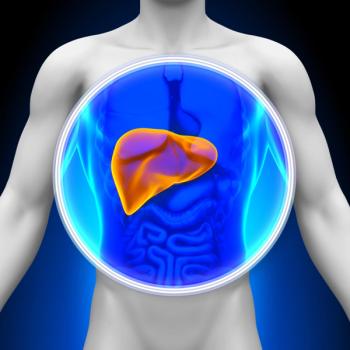
Asciminib May Improve HRQOL Vs Bosutinib in Resistant/Intolerant CML-CP
Asciminib does not appear to interfere with the general life activities of patients with resistant/intolerant chronic phase chronic myeloid leukemia in the phase 3 ASCEMBL trial.
Treatment with asciminib (Scemblix) produced stable patient symptoms and health-related quality of life (HRQOL) compared with bosutinib (Bosulif) among those with resistant/intolerant chronic phase chronic myeloid leukemia (CML-CP), according to patient-reported outcome (PRO) findings from the phase 3 ASCEMBL trial (NCT03106779).
Over 48 weeks of treatment, symptom severity scores tended to decrease among patients receiving asciminib and generally remained close to baseline for those receiving bosutinib, although the magnitude of mean changes were small and did not reach a clinically meaningful threshold in each arm. Patients receiving asciminib maintained or showed a decreasing trend in severity in all symptom items, with notable improvements in symptoms of fatigue and dry mouth that were not clinically meaningful.
Patients receiving bosutinib experienced increases in severity for the symptoms of diarrhea, nausea, and vomiting. The overall mean increase in diarrhea severity score was 1.5 points for those receiving bosutinib, which is indicative of a clinically meaningful change in symptoms. Additionally, diarrhea had the greatest difference in score between treatment arms at –1.7 points.
Patients in the asciminib arm had an increase of 4.8 points (95% CI, 2.4-7.2) from baseline for HRQOL that did not reach the clinically meaningful threshold of 7 points. The difference in HRQOL scores from baseline between treatment arms was 3.9 points (95% CI, –0.5 to 8.2), which was not clinically meaningful. Additionally, 47% of patients in the asciminib arm reported that their CML symptoms had improved by week 48 of treatment compared with 20% of those in the bosutinib arm.
“Patients with resistant/intolerant CML-CP treated with asciminib in ASCEMBL showed a trend for improvement in CML disease- and treatment-related symptoms and HRQOL compared with baseline and relative to bosutinib within the first 48 weeks of treatment,” the study authors stated. “No observed deterioration in CML-specific symptoms, HRQOL, or work productivity aligns with the manageable and well-tolerated adverse [effect] profile of asciminib, further supporting the clinical value and risk/benefit evaluation of asciminib for the treatment of patients with CML-CP….”
Investigators of the multi-center, open-label, phase 3 ASCEMBL trial compared the efficacy of asciminib and bosutinib in the treatment of patients with CML-CP who were resistant or intolerant to at least 2 prior lines of tyrosine kinase inhibitors (TKIs). Overall, 157 patients received 40 mg of asciminib twice a day, and 76 received 500 mg of bosutinib once daily for at least 96 or until disease progression or unacceptable toxicity.
For this PRO analysis, investigators used the MD Anderson Symptom Inventory (MDASI) – CML questionnaire to evaluate CML symptoms and interference with daily life, the five-level EQ-5D (EQ-5D-5L) questionnaire for general HRQOL, and the Patient Global Impression of Change (PGIC) – CML for patients’ impression of change in CML symptoms. The Work Productivity and Activity Impairment (WPAI) – CML questionnaire also measured the effect of patients’ work and activity.
The median patient age at baseline was 52 years (range, 19-83), and 52% of patients were female. Additionally, 64% and 35% of patients in the asciminib and bosutinib arms, respectively, had discontinued prior TKI treatment due to lack of efficacy and tolerability.
PRO completion rates were comparable for the EQ-5D-5L, PGIC-CML, and MDASI-CML questionnaires. Moreover, 95.5% and 90.8% of those in the asciminib and bosutinib arms, respectively, reported their current employment status for the WPAI-CML. Of these patients, 46% and 36% of those in each respective treatment arm reported that they were currently working at baseline.
Overall, 6.5% of patients receiving asciminib reported having a reduction in their activity impairment compared with 1.0% of those receiving bosutinib. Investigators noted similar trends of differences favoring asciminib including changes in percent work time missed, impairment while working, and overall work impairment, although the magnitudes of these changes did not reach a clinically meaningful threshold of 15%.
Changes in symptoms from baseline across subgroups were generally consistent with findings in the overall study population. Patients receiving asciminib experienced a trend towards improvement in symptom severity from baseline regardless of whether they discontinued prior TKI therapy due to TKI failure or intolerance. Investigators noted that the trend toward improved HRQOL from baseline in favor of asciminib was greater for patients who experienced prior TKI failure.
Reference
Réa D, Boquimpani C, Mauro MJ, et al. Health-related quality of life of patients with resistant/intolerant chronic phase chronic myeloid leukemia treated with asciminib or bosutinib in the phase 3 ASCEMBL trial. Leukemia. 2023;37:1060-1067. doi:10.1038/s41375-023-01888-y
Newsletter
Stay up to date on recent advances in the multidisciplinary approach to cancer.
































































































